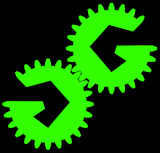Great Scott Gadgets
Software Defined Radio with HackRF, Lesson 9
Aliasing
In order to clearly see my screen during the demonstrations, viewing the video in full screen mode may help. Even better: You can download this video in high resolution (720p). (torrent)
In this Lesson
- lesson 8 homework review
- FSK demodulation
- negative frequencies
- aliasing
- lesson 4 homework review
- mysteries solved
- cosine as sum of two complex exponentials
- sampling theorem<
- anti-aliasing filters
- bandpass sampling
Homework
-
Run the flowgraph and use the Average option to view the frequency content of the noise.
-
Add a Low Pass Filter to the flowgraph, using sliders to control the filter’s cutoff frequency and transition width. Configure both sliders with a default value of samp_rate/8, a minimum of samp_rate/1000, a maximum of samp_rate/2, and 1000 steps.
-
Observe how the filter’s frequency response changes when adjusting the sliders. The Average option may be helpful.
-
Check your CPU utilization with the transition width set very low. How does it compare to the utilization observed with the transition width set to a moderate value?
-
Try high pass and band pass filters instead of a low pass filter.
Resources
- the FCC filing for MLBHLIK-1T, the device used in the video
- the lesson 8 homework review flowgraph: lesson9a.grc
- the lesson 4 homework review flowgraph: lesson9b.grc
- the lesson 9 homework flowgraph: lesson9c.grc
Errata
- I forgot to mention in the video that I intentionally chose a Frequency Shift Keying (FSK) device rather than an On-Off Keying (OOK) device for the lesson 8 homework review to serve as an illustration of what may have happened if you tried to do the lesson 8 homework with an FSK device. Lesson 8 contains an example of the process with an OOK transmitter which is more commonly found in Remote Keyless Entry (RKE) systems.
- 5 October 2015: I used the WX GUI option in GNU Radio Companion. The default has since changed from WX GUI to QT GUI in the Options block. If you are using a newer version of GNU Radio, you’ll need to change it back to WX GUI to follow along with my flowgraph.
Software Defined Radio with HackRF is copyright 2014, 2015 by Michael Ossmann and is released under the CC BY license.

